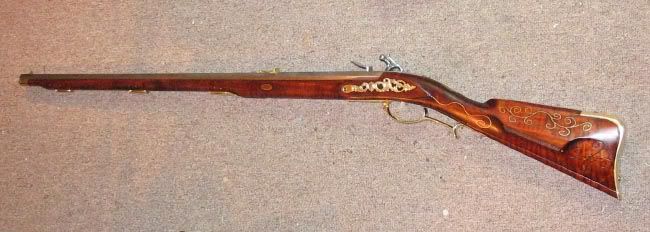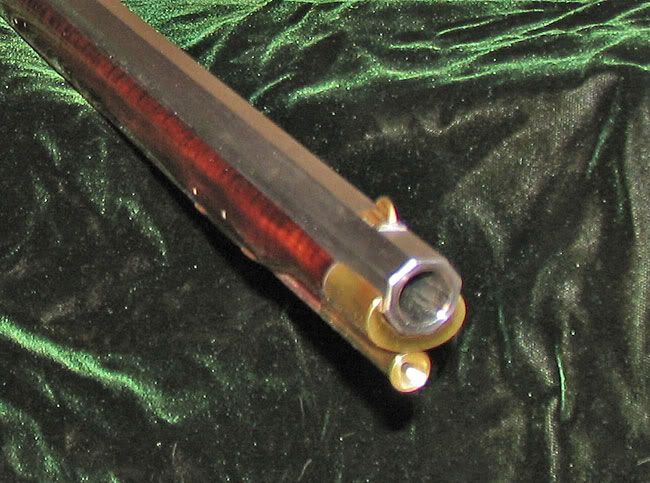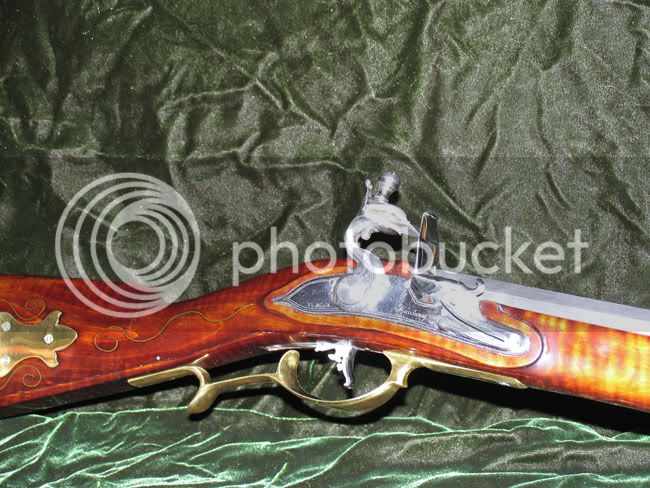I recieved a PM asking me why I call my present project a "B GUN".
I started to answer his question, but I got to thinking (always dangerous) maybe someone else would like to know.
With that in mind, here is the story:
I don't know if you remember, but I screwed a brand new Colerain .54 cal swamped barrel by drilling the barrel staple holes all the way thru the wall about 5 1/2 inches from the muzzle. I posted the question "what should I do with it?"
Of course I got lots of "Give it to me"s but being a tightwad when it comes to $200 I decided I would build a gun with a cut off barrel.
Because the barrel was for a "Transitional" gun, I decided I would build a shortned version of one.
With the 1750 French & Indian war in mind I decided it should have a French lock, thimbles, and sideplate. Now a gun built during those years, in the British Colonies using French hardware could truly be called a *******.
In several posts, I refered to it as a ******* Gun and although I never heard a word against using the expression, I decided to shorten it to "B Gun".
Although some would say this gun never existed, one of the things about building a gun is it gives a person the choice of either building an exact replica or using the known information of a period to create what might have existed.
This gun is the latter.
The story of the gun (my version) is as follows:
A young man enlisted by the British to fight the French and made it up into Canada. The small party he was with was in an ambuscade by the Indians who were loyal to the French. He was the only one to escape although he lost all of his accoutrements.
Wishing to get to the Colonies, he set out towards his home. In his travels, he came across a French spy who had wandered from his camp. The Frenchman was armed with a Fusil Fin.
Following a brief scuffle, our hero ended up with the gun, powder and some ball.
The trip was arduous and took a lenghty amount of time. He soon found his supply of ball exhausted and resorted to using rocks. During a fall, the Fusils stock was cracked at the wrist and the butt was soon lost. In general the Fusil was barely servicable by the time he got home.
He had grown very fond of it however as without it, he would have died a lonely death, hundreds of miles from home.
Contacting the village gunsmith, they determined that the lock was still in good repair however the barrel and stock were ruined.
Having little money, the gunsmith offered him a damaged swamped .54 caliber barrel. The previous owner had fired it with the muzzle plugged with snow which resulted in the muzzle being split back about 5 inches.
The smith said shortening it wouldn't cause a problem, and indeed the gun would not only be servicable but would be especially handy for use in a Canoe for it would be light weight and due to its short length it could easily be reloaded in the Canoe. Being a .54 caliber, it would be capable of taking anything available, be it Indian of Beast.
The gunsmith was an old German and had a fond place in his heart for the heavy stocked, short barreled Jeager from his homeland.
Thus it was decided to build an Americanized Jeager style gun using all of the Fusil Fin parts which could be of service.
To save additional expenses, the gun was to be built by the Smiths apprentice. He could practice his limited carving skills and try his hand at building and installing a metal patchbox cover which was then becoming one of the new trends in the area.
The final product would therefore be a combination of German Jaeger, American trends and French hardware. Truly a ******* if ever there was one.
I started to answer his question, but I got to thinking (always dangerous) maybe someone else would like to know.
With that in mind, here is the story:
I don't know if you remember, but I screwed a brand new Colerain .54 cal swamped barrel by drilling the barrel staple holes all the way thru the wall about 5 1/2 inches from the muzzle. I posted the question "what should I do with it?"
Of course I got lots of "Give it to me"s but being a tightwad when it comes to $200 I decided I would build a gun with a cut off barrel.
Because the barrel was for a "Transitional" gun, I decided I would build a shortned version of one.
With the 1750 French & Indian war in mind I decided it should have a French lock, thimbles, and sideplate. Now a gun built during those years, in the British Colonies using French hardware could truly be called a *******.
In several posts, I refered to it as a ******* Gun and although I never heard a word against using the expression, I decided to shorten it to "B Gun".
Although some would say this gun never existed, one of the things about building a gun is it gives a person the choice of either building an exact replica or using the known information of a period to create what might have existed.
This gun is the latter.
The story of the gun (my version) is as follows:
A young man enlisted by the British to fight the French and made it up into Canada. The small party he was with was in an ambuscade by the Indians who were loyal to the French. He was the only one to escape although he lost all of his accoutrements.
Wishing to get to the Colonies, he set out towards his home. In his travels, he came across a French spy who had wandered from his camp. The Frenchman was armed with a Fusil Fin.
Following a brief scuffle, our hero ended up with the gun, powder and some ball.
The trip was arduous and took a lenghty amount of time. He soon found his supply of ball exhausted and resorted to using rocks. During a fall, the Fusils stock was cracked at the wrist and the butt was soon lost. In general the Fusil was barely servicable by the time he got home.
He had grown very fond of it however as without it, he would have died a lonely death, hundreds of miles from home.
Contacting the village gunsmith, they determined that the lock was still in good repair however the barrel and stock were ruined.
Having little money, the gunsmith offered him a damaged swamped .54 caliber barrel. The previous owner had fired it with the muzzle plugged with snow which resulted in the muzzle being split back about 5 inches.
The smith said shortening it wouldn't cause a problem, and indeed the gun would not only be servicable but would be especially handy for use in a Canoe for it would be light weight and due to its short length it could easily be reloaded in the Canoe. Being a .54 caliber, it would be capable of taking anything available, be it Indian of Beast.
The gunsmith was an old German and had a fond place in his heart for the heavy stocked, short barreled Jeager from his homeland.
Thus it was decided to build an Americanized Jeager style gun using all of the Fusil Fin parts which could be of service.
To save additional expenses, the gun was to be built by the Smiths apprentice. He could practice his limited carving skills and try his hand at building and installing a metal patchbox cover which was then becoming one of the new trends in the area.
The final product would therefore be a combination of German Jaeger, American trends and French hardware. Truly a ******* if ever there was one.







